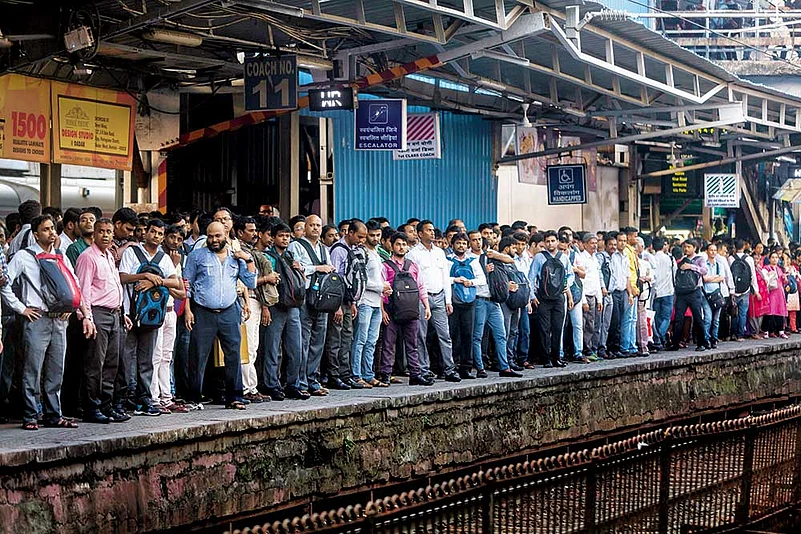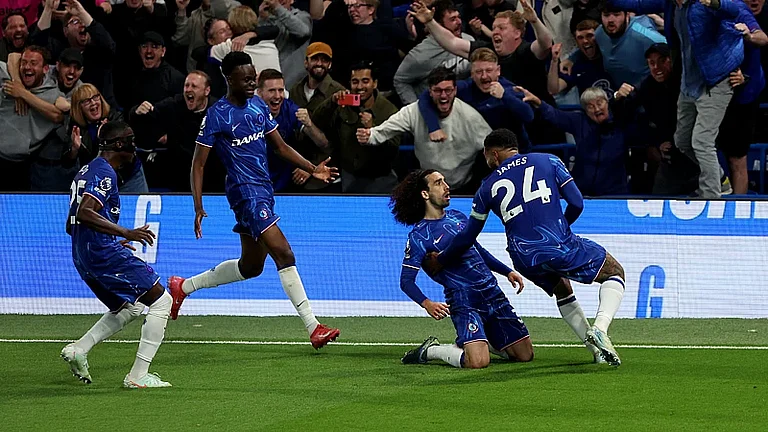The Marxist expression ‘sack of potatoes’ about peasant political consciousness could well be true of the Indian middle class. This is a class which remains indecisive when it comes to getting their index finger marked going by the voting behaviour in the ongoing general elections. But the same people will use their index finger to point out where political flaws exist. They crib about what all is not going right with the political system throughout the year, but when it comes to plunging into the political system by way of action, they appear to be neither here nor there. They are fence-sitters, not willing to join any side.
In Bangalore, where the Lok Sabha polls took place on April 18, the low voter turnout yet again led to questions of which voting block was snoozing. The city’s urban middle class is the top suspect. This, despite the fact that polling day in the city this year was nestled in between an extended weekend and hence there were various initiatives by the authorities to ensure Bangaloreans inked their fingers. One of them was an appeal made to weekend holiday destinations in the vicinity not to take in bookings. Bangalore’s turnout (Bangalore South recorded the lowest in the city at 53.48 percent) was low, but still higher than Hyderabad’s 44.75 percent.
“Why voter turnout is low is an eternal mystery,” says Prof Trilochan Sastry of the Association for Democratic Reforms. “In all urban areas and metros, it has always been low. It’s low in New York and in London.” Blaming it entirely on urban voter apathy, or specifically the middle class, isn’t very convincing either. So, could it be to do with the voter rolls? Many reckon so. “I think they have improved but I don’t think they have succeeded hundred percent. The job of getting the rolls right is always a work in progress,” says Sastry.
The class divide is more sharp in the rural areas, with only two major classes, haves and havenots. Hence, the middle class is not associated with rural India that much, or in any case, it is present in small numbers there. It is in cities that the middle class exists within a whole spectrum: upwardly mobile, lower middle class, upper middle class, etc. Hence, when a middle class is being referred to, it is this vast urban collection of subsets. Middle class support or participation making a difference in elections varies from constituency to constituency. There is no general rule about it.
Going by trends in Bangalore, Narendar Pani, School of Social Sciences, National Institute of Advanced Studies, points out that urban constituencies see the lowest voting. “I can’t say whether it is the lower or upper middle class that votes in low numbers, but the urban constituency knows it can influence the policies without the electoral processes. Essentially, the influence on policy comes through people like Nandan Nilekani and groups like that. It has very little to do with the electoral process,” says Pani. “They don’t have to go through the tedious process of voting and holding the elected representatives accountable. The rural middle class is different. They generally tend to vote more, vote in groups and then ensure that the group negotiates with the electoral representatives,” he adds.

So, the middle class is politically active, but this idea of politics is a more broad-based one where they try to influence power and policies and generate groupings. They can be very active in creating influence groups, but they are not very active in the electoral process. Low voter turnouts in cities reveal that despite being engrossed with politics, middle class groups have shown a distaste or contempt for elected representatives.
The last time someone from the middle class stood for elections, like Nandan Nilekani, he lost by a wide margin. This shows he had little support from his class. Others like M.J. Akbar stood as representatives of a political party and not as independent middle class candidates.
It is a class that looks primarily for economic status: ‘what will make a profit?’ they think. The middle class also has no problem in taking extreme nationalist positions while, at the same time, being the group with the largest number of aspirants for jobs and migration abroad.
The middle class’s electoral apathy, however, is not a one-sided affair. A cursory look at the manifestos of the main political parties for this election hardly makes space for specific middle class issues. This has always been the case if you ask Arun Kumar, owner of Ludhiana-based MK Printing Press and member of Ludhiana Printing Press Association. “The middle class has never been a part of manifestos because they never specifically demanded it. You ask any middle-class family, they would say poll issues are inflation, infrastructure development and government facilities. Our classes have never gone beyond these three-four factors, and have become persona non-grata,” says Arun.
It’s only a few times that the middle classes have come forward and used the ballot box to express their angst. Emergency, the Dalit agitation and the Anna Hazare movement in Delhi are a few such times over the last several decades. Today, when there is lingering angst over policies like demonetisation and GST, which are believed to have killed many small enterprises and led to job losses, there hardly seems any enthusiasm for the electoral verdict.
“Middle-class work is limited to the city’s municipal councillor or corporator, which involves issuing of birth certificate, death certificate, attesting documents, sewerage, road and parks. Beyond this, the middle class doesn’t really engage with politicians,” says Akshay Rathore, a government employee. Citing the example of unfinished flats in Noida-Gurugram, Rathore expresses anguish that no politician has been able to resolve that crisis. “It’s one of the reasons why urban middle classes don’t engage with politicians. We are neither part of political rallies nor the political discourse,” adds Rathore.
Jagdeep Chhokar, professor at IIMA and co-founder of Association for Democratic Reforms, India, emphasises that the middle class is not an organised monolith. “It is very dispersed and diverse. The pattern of middle class behaviour changes from tribal to rural to semi urban to peri urban to metros. “That is what political parties take advantage of. My middle class community will vote for me while yours will vote for you,” says Chhokar. He points out that generalising the middle class is very difficult. The lower sections of the middle class are more worried about their bread and butter than its upper strata. The upper strata are under the impression that they can play or manipulate the system to their advantage. So if there is anything wrong in the system, it doesn’t bother them as they are confident of getting their work done whether it is a drivers’ license or power or a water connection.
Unlike the upper middle class, the lower middle classes are not able to play the system to their advantage so they take the elections more seriously. “I don’t think many people think elections make a difference because we have reduced them to a farce. We no longer talk about governance in the elections or about how the society should organise itself during elections. We only talk about who has not done what and who is corrupt and not corrupt,” says Chhokar, adding that he is happy that the lower strata of the middle class is more serious about the elections than the upper strata.
Jayati Ghosh, who teaches at JNU, points to the whole new level of aspirations driving both the poor and the middle classes. “When those aspirations are not met, people tend to blame others. Life has become more insecure and difficult for almost everybody in the middle classes. Very few of the well-off and high salaried are benefiting while everybody else is feeling the pinch,” says Ghosh.
While there may be nothing overt in the election manifestos, Ghosh states that a lot of the government policies are framed to curry favour with the middle class: for instance, the constant increase in dearness allowance for government employees or the raising of income tax limits, all are middle class gestures. Except in a few southern states like Kerala and Tamil Nadu, the middle classes have not been taught to demand good public facilities. They have only been taught to go for privatisation of public services and utilities.
In Delhi, AAP’s policies have been directed towards the urban poor through facilities like mohalla clinics, better government schools, etc. But does that make the Delhi middle class feel neglected? Not quite, as the middle class has generally been the beneficiary of most government policies. For instance, low inflation benefits the middle class.

The daily grind in a Calcutta bus
One big debate is that farmers are losing out while the middle class benefits. The Modi government’s failure to address growing unemployment or farmer distress does not appear on the ground to impact the middle class’s day-to-day life. But then, what awakens them are issues like GST. For a large number of middle class families spoken to for this report, the negative impact of GST on their house-owning dreams is a matter of great anguish. “Look at the registration fee after adding the GST levied on a 2 BHK flat. For a Rs 70-80 lakh flat one has to pay more than Rs 7-8 lakh tax. If this is not burdening a middle-class man then what else is?” asks Lakshman Rao, a government employee in Telangana.
As for Modi’s drive against black money, Rao says that while electronic payments might have been made mandatory, most of the black money is parked in land purchases in benami names by politicians, bureaucrats, and the influential. At the same time, Minakshi Shailendra Kumar, Vice Principal of Secunderabad Public School, is happy that the “payment of teaching staff salaries, or their additional payment for evaluation work, or students paying their fee, all have become hassle-free with ‘digitalisation’ or ‘electronic payments’.”
Ajitabha Roychoudhury, professor of economics at Jadavpur University, says while small manufacturers have been adversely affected by demonetisation and GST, the salaried-class have also not benefited much over the last few years, except for a small income tax relief in the last budget. “The BJP came to power by promising to fight corruption at all levels but failed to deliver,” Roychoudhury says. “The dream of the educated middle class is to get better-paying jobs or start a small or medium entrepreneurship but successive governments have failed to address this sector”.
G.K. Karanth, ex-professor at the Bangalore-based Institute for Social and Economic Change, states, “The middle class has become a somewhat cynical class which has lost any fair hope of things happening by plan. Somehow the middle class has not only been the classic Marxian opportunist but has also hoped that opportunities will sink in place.”
In the absence of proper data on either job creation or tax collection, political parties are fooling the people, says Roychoudhury adding that dole culture is no answer to unkept promises to boost the education and healthcare.
For an informed middle class person, there are no issues engaging voters this time. If you study the political manifestos, parties seem like dream merchants. There is either NYAY or some waiver and more promises of those kind. Everybody seems to be offering the moon. But no political party is talking about how they are going to improve civic amenities, tackle waste management and improve environment, all common middle class talking points.
One can say that the middle class today is so much a part of the selfie culture—that focuses on itself in a private frame —that where it matters, they are not in the frame. And elections surely warrant their participation in larger numbers.
***

Sunil Gaychare
Sunil Gaychare, 38, is a manager in the finance department of a private company. In the past four to five years he has witnessed many changes in his personal life as well as in society. “Over all, prices have increased, most importantly petrol prices. It has actually affected my moving around as I commute a lot for work,” says Sunil. “Not to mention the traffic snarls all over Mumbai because of the ongoing metro work.” He points to economic slowdown because of which increments are hard to come. “The job market is very tight. My wife left her job to take care of our child three years ago but now it is hard for her to get a job.”
Sunil has also been disillusioned by the government’s schemes. “Initially, I thought demonetisation was good for curbing black money but after RBI’s report came out saying 99 per cent of scrapped money had returned to banks, I realised it had flopped,” he says. Sunil says that while the Congress’ NYAY may help temporarily, both the public and private sector need to ensure minimum wages for the poor and the middle class.

Dhananjay Joshi
Dhananjay, who sells farm equipment, recently opened a café in Nashik. He has weathered several storms in his entrepreneurial life—he first entered the business in partnership in 2002 and then went solo in 2011. “I think earlier people didn’t realise how much tax they were paying with VAT and other indirect taxes, which is why there was so much criticism against GST. But if you ask me, people who were not meticulous or were having some sort black transactions, faced difficulties during demonetisation and GST. We had no trouble. In fact our business has grown by 30 to 35 per cent.”
Dhananjay is of the opinion that one must be ready to undergo some difficulties for the improvement of the country. He vehemently opposes the idea of subsidy or any financial help such as loan waivers or the Congress’s NYAY scheme, “I have seen extremely wealthy farmers, who make profits and don’t repay their loans because of loan waivers. When you give anything for free, people take it for granted. I don’t think any of these schemes are a good idea.”
By Lola Nayar and Jyotika Sood with inputs from Ajay Sukumaran in Bangalore, M.S. Shanker in Hyderabad, G.C. Shekhar in Chennai, Prachi Pinglay-Plumber in Mumbai and Probir Pramanik in Kolkata


























